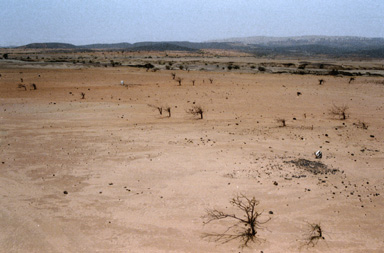DesertificationDesertification is the expansion of dry lands due
to poor agricultural practices (e.g. overgrazing, degradation of
soil fertility and structure), improper soil moisture management,
salinization and erosion, forest removal, and climate change.
DD 13.2 Desertification in Africa
Two common misconceptions prevail about desertification, that it spreads from a desert core and drought is responsible. Desertification spreads outward from any where excessive abuse of the land occurs and far from any climatic desert. Droughts do increase the possibility of desertification if the carrying capacity of non-irrigated land is exceeded. Well-managed land can recover from the effects of drought. Combining drought with land abuse sets the stage for desertification. Cause of DesertificationDesertification comes about by a complex interaction between the natural environment and human activities. The cause may vary from region to region on account of economic conditions, population pressure, agricultural practices, and politics. Human activities that destroys surface vegetation, degrades soil structure and fertility, impedes water infiltration, and causes soil drying promotes desertification. This is especially true for the fragile transition zone between arid and semiarid land where human activity has stretched the ecosystem to its limit causing expansion of deserts. Population growth and its demand on agricultural resources has promoted the desertification process. Over cultivation, for example, causes declining soil fertility leading to falling crop yields. Over use leads to crusting of exposed topsoil by rain and sun that increases runoff, water erosion and gullying. Soil drying promotes wind erosion and encroachment of sand dunes on arable land. Overgrazing has several effects. It:
Forest cutting for fuel wood has deforested large tracks of land in Africa and Asia encouraging desertification. |
